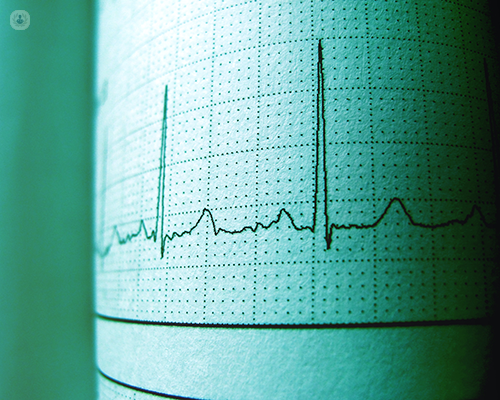Simple pacing: Do I need a pacemaker?
Escrito por:A pacemaker is a small, electronic device with a pulse generator and a computer circuit that is surgically fixed in the chest. Pacemaker implantation (fitting) is a leading cardiac procedure with approximately 50,000 pacemakers implanted each year.
Here, Dr Kaushik Guha, esteemed consultant cardiologist, explains when a pacemaker is required, how is it fitted and placed, and its longevity.

When is a pacemaker considered?
A pacemaker is a cardiac treatment which involves the implantation (fitting) of technology within the human body. The purpose of a pacemaker is purely to prevent the patient's heart going slow (bradycardia). Hence, cardiologists contemplate pacemakers in patients who are experiencing slow heart rhythms (bradycardia arrhythmia) and who are prone to blackouts (syncope), dizzy or funny turn episodes (pre-syncope). Such episodes may lead to physical trauma including hip fracture, head and facial injuries.
As a result, a pacemaker is considered both to correct a slow heart rhythm and to prevent the associated possibility of physical trauma.
Is it common for a pacemaker not to be effective once placed?
Prior to considering pacemaker implantation, there should be a thorough evaluation by the cardiologist concentrating on the patient’s history and a physical examination. The basic investigations required prior to considering pacemaker implantation include a 12-lead ECG (heart tracing), echocardiogram (ultrasound of the heart - heart scan) and potentially, an ambulatory heart monitor. This is to ensure that the pacemaker will be appropriate and will correct the clinical situation.
How exactly are pacemakers fitted and placed?
Pacemakers in human beings were originally invented in the 1950s and since then, the techniques of implantation have evolved. Currently, with regards to simple pacing, there are two possibilities.
The established modern technique is to introduce the leads through the veins, normally around the collarbone (clavicle) area. These are then positioned on the right-hand side of the heart. Pacemakers may either come in assignee lead or dual lead variety. The cardiologist will make the decision on which one to use with the patient, taking all of the valuable clinical information into account. The actual lead positioning process is performed under fluoroscopic guidance (X-ray imaging) and the average procedure takes 45 minutes to one hour. Normally, the patient is able to go home within a few hours and a pacemaker would commit the patient to longer term follow up with the pacing clinic.
An alternative, more embryonic, technology is a 'leadless' pacemaker. This is just entering clinical practice and is still only a selective technology for a minority of patients.
Both types of pacemakers mandate the patient to have a commitment to follow up with a pacing clinic. This either means a check of the pacemaker using a physical programmer (computer) or alternatively, using the remote download technology through a technology hub supplied by the manufacturer, to transmit clinical information about the pacemaker securely to the pacing clinic.
How safe is it to put in a pacemaker?
Generally, the implantation of a pacemaker is safe, but there are risks at the time of implantation which include infection, bleeding, damage to the lungs (pneumothorax - air pocket of the lungs), lead displacement or dislodgement leading to a repositioning. In rare occasions, there is damage to the heart muscle, which causes a potentially life-threatening leak of blood around the heart. The general risk profile is five to 10 per cent and the risk of life-threatening problems is 1 in a 1000.
How long are pacemakers typically effective for?
Pacemaker batteries housed within the pacemaker generator are usually hardy and last on average 10 to 15 years. However, if a patient becomes more reliant on the pacemaker, then this will lead to more rapid battery depletion. No patient's pacemaker is able to run out of battery for there are preset safety margins built into the battery monitoring equipment which are detected by the pacing clinic. Hence, providing the patient continues to adhere with follow up, once a battery has started to run out, they will be booked for a battery generator change.
How many pacemakers might any given individual require in a lifetime?
The number of pacemakers within a lifetime varies greatly on the needs of the patient, the reliability of the technology and the dependency on the pacemaker. For instance, if a child is fitted with a pacemaker, he or she may require many pacemakers and revisions throughout their lifetime, whereas a more elderly adult may only require a solitary pacemaker to prevent funny turn episodes and prevent falls.
What lifestyle adjustments should people who have had a pacemaker make? Are there any side effects associated with having a pacemaker fitted?
There are no day-to-day restrictions for patients with pacemakers. Following the implantation process, there is an initial restriction to moving the affected arm on the side of the pacemaker. This lasts until the first pacing check, which normally takes place around six weeks after implant. Overall, the reason behind restricted arm movements is to allow the pacemaker’s generator and leads to settle.
The Drivers and Vehicle Licensing Agency normally states a one-week restriction from driving, following pacemaker implantation.
If you require a pacemaker and wish to consult your options, don’t hesitate to visit Dr Guha’s Top Doctors profile today.


